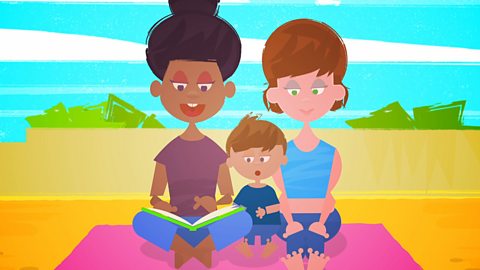Imagine that you are teaching your child the word dog by showing them a cuddly toy that looks like a puppy and saying ŌĆ£doggieŌĆØ.
How will your child learn that the word ŌĆ£doggieŌĆØ refers not just to this cuddly toy, but also to all members of a species? How do they know that not everything with four legs is a ŌĆ£doggieŌĆØ? And not all cuddly toys are ŌĆ£doggiesŌĆØ?
ItŌĆÖs a very big ask for their little brains but one with a very simple answer.
In the video below, we explain how showing your child things in lots of different contexts or scenarios can really boost their understanding of new words.
ItŌĆÖs always fun to get out and about and itŌĆÖs great for your toddlerŌĆÖs language learning too. Why? Because It turns out that talking to children about things in lots of different places helps them learn new words.
How do we know? Well, in a recent study, researchers showed children pictures of exciting new toys, whilst playing audio of the toyŌĆÖs name. Half the children saw the toys on a white background, and half saw them on different coloured backgrounds. Then, in the second part of the study, they showed them all the toys at once and played audio of the toysŌĆÖ names. The researchers used-eye-tracking technology to record where the toddlers looked on the computer screen, when they heard the words.
The results? Only the children whoŌĆÖd seen the coloured backgrounds looked at the correct toys when they heard their names. So, what does that mean for your little one? It means you can help their learning by mixing it up a little and letting them see things in lots of different places. Show them a toy duck, a duck in a pond and a duck on a sign. It helps them learn what exactly makes a duck: feathers, wings,ŌĆśquack quackŌĆÖ, that sort of thing, and what they can ignore:the plastic, the pond, the sign. By understanding exactly what the words stand for, they can remember them and use them much more easily.
When do toddlers understand language?
Your child will start to understand their own name at around four months old.
At around 12 months, your child will understand the names of things they see or use often. But they might use the same word to refer to different things. For example, they might call all animals ŌĆśdoggieŌĆÖ.
In between 12 and 24 months, your child will learn to use and understand more words (and more types of words).
At first theyŌĆÖll understand mostly nouns like ŌĆścatŌĆÖ and ŌĆśbusŌĆÖ. After this theyŌĆÖll start to understand a few verbs like ŌĆśeatŌĆÖ and ŌĆśrunŌĆÖ. Adjectives usually follow.

How to help your child learn the meanings of words?
We often help our children learn the names of objects and things by pointing at them and naming them.
This is a great way to help language learning, especially when your child is really engaged in the object you're talking about. But how will your child know exactly what you are pointing to?
For example, if you show them a toy duck, how do they know that the word "duck" relates to the animal and not the material, the colour or another of its properties?
This is why it's really important to show your child lots of different examples of a word, so they can start figuring our the meaning more easily.
Show them a toy duck, a duck in a pond and a duck on a sign.
That way they can learn what exactly makes a duck: feathers, wings, a bill and webbed feet. And they also learn what they can ignore: the plastic, the pond, the sign.
By understanding exactly what the words stand for, they will be able to remember them and use them much more easily.
You don't have to do this all at once. Just keep your eyes peeled when you're out and about for opportunities to introduce lots of words in all these different contexts.

The science of learning new words
In a recent study, researchers showed children pictures of exciting new toys, whilst playing audio of the toyŌĆÖs name.
Half the children saw the toys only on a white background, and the other half saw them on different coloured backgrounds.
In the second part of the study, the scientists showed the children all the toys at once and played audio of the toysŌĆÖ names. The researchers used-eye-tracking technology to record where the toddlers looked on the computer screen when they heard the words.
Only the children whoŌĆÖd seen the coloured backgrounds looked at the correct toys when they heard their names.






